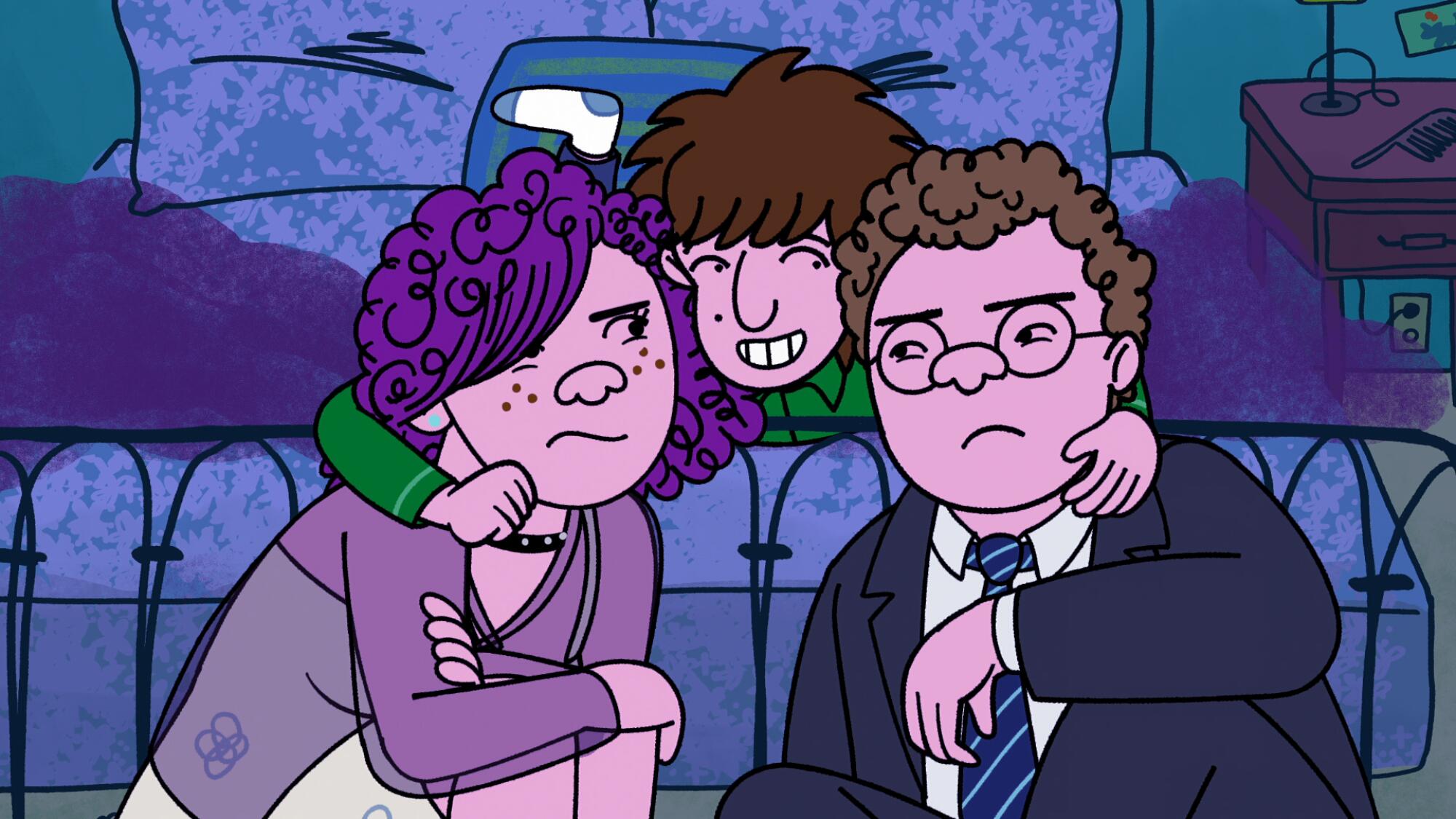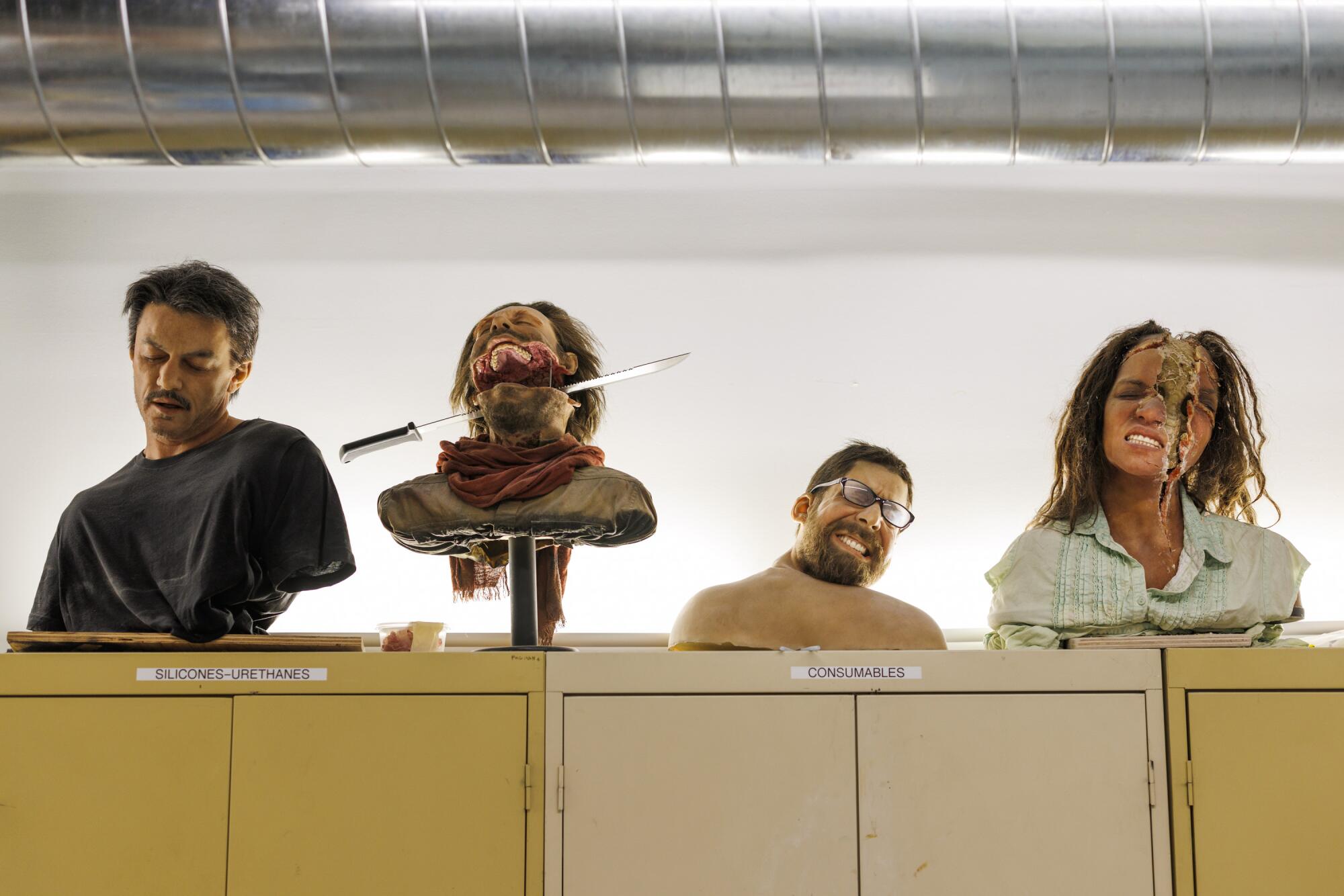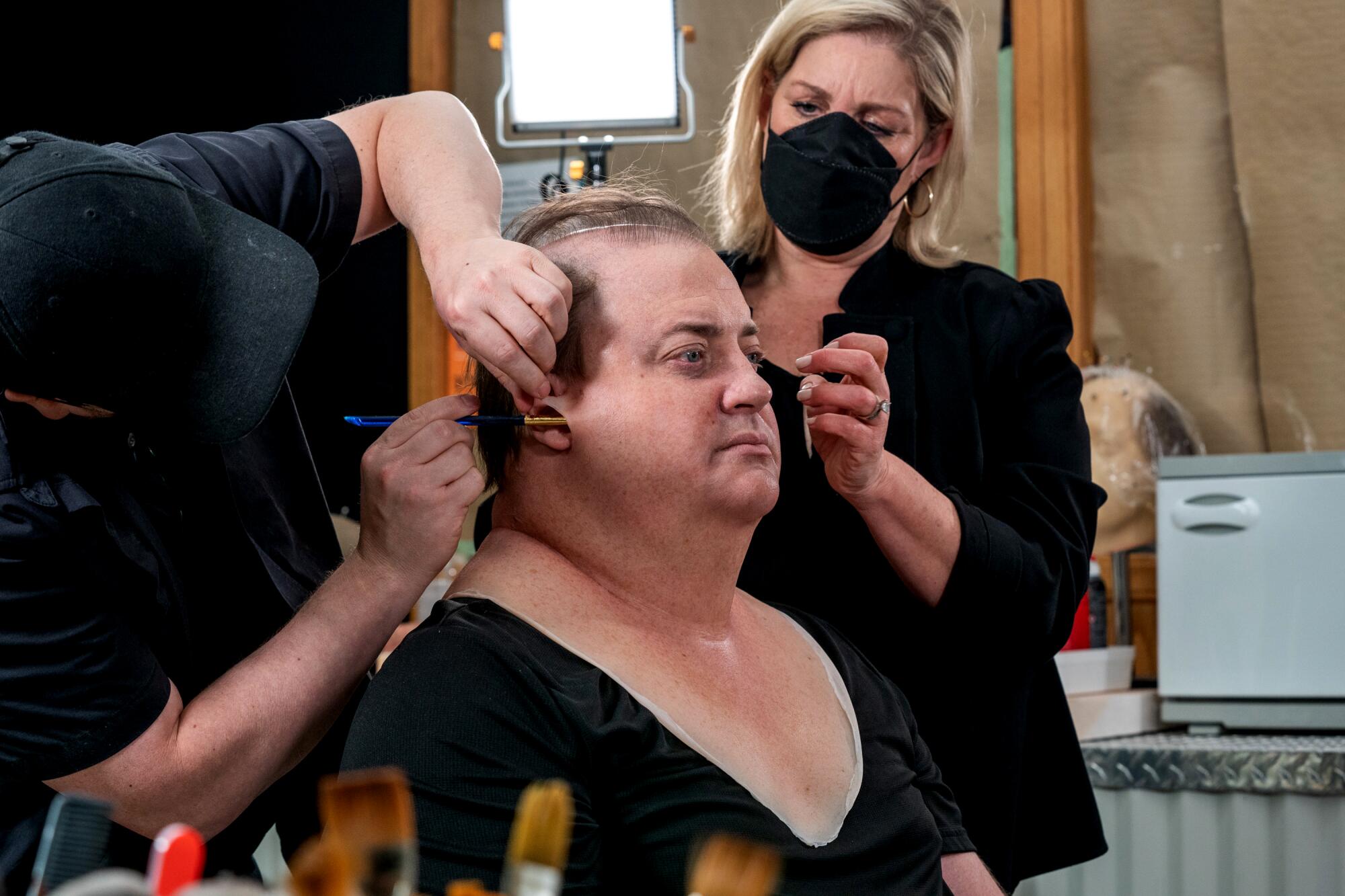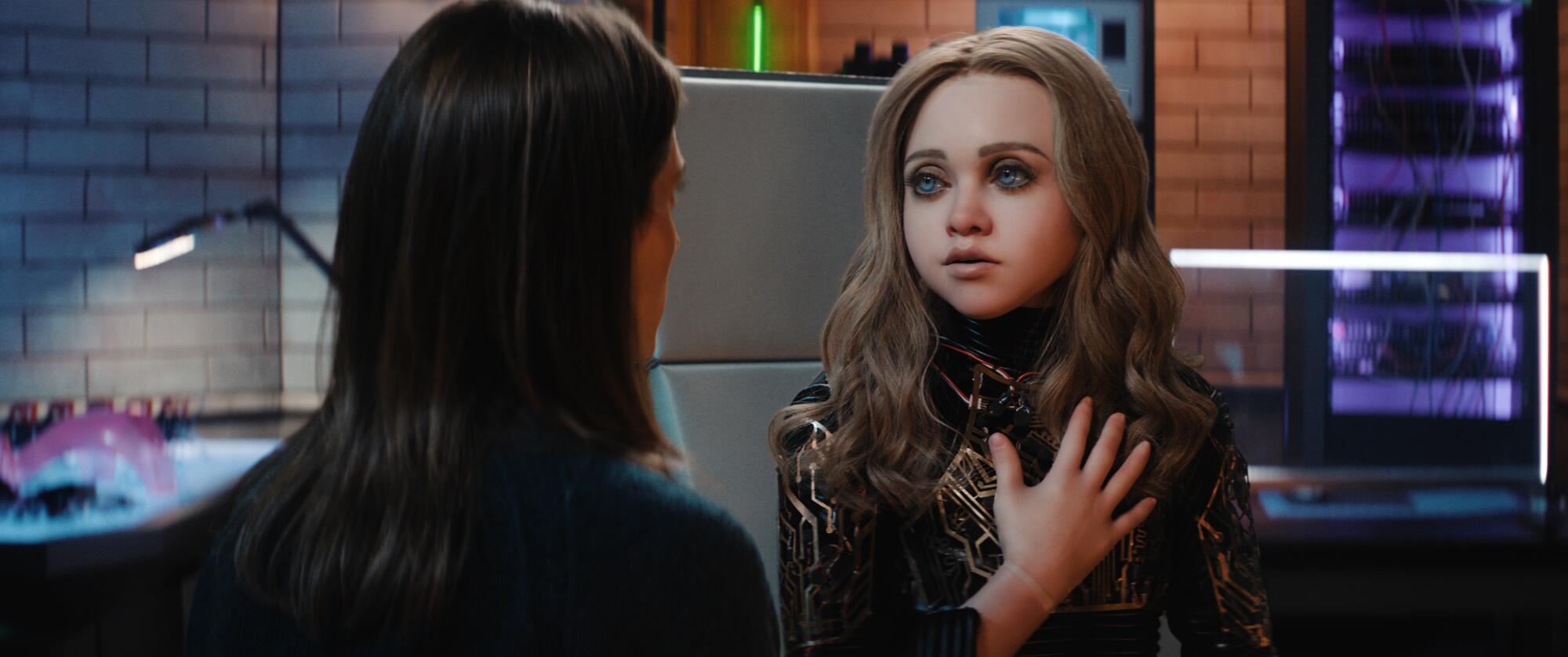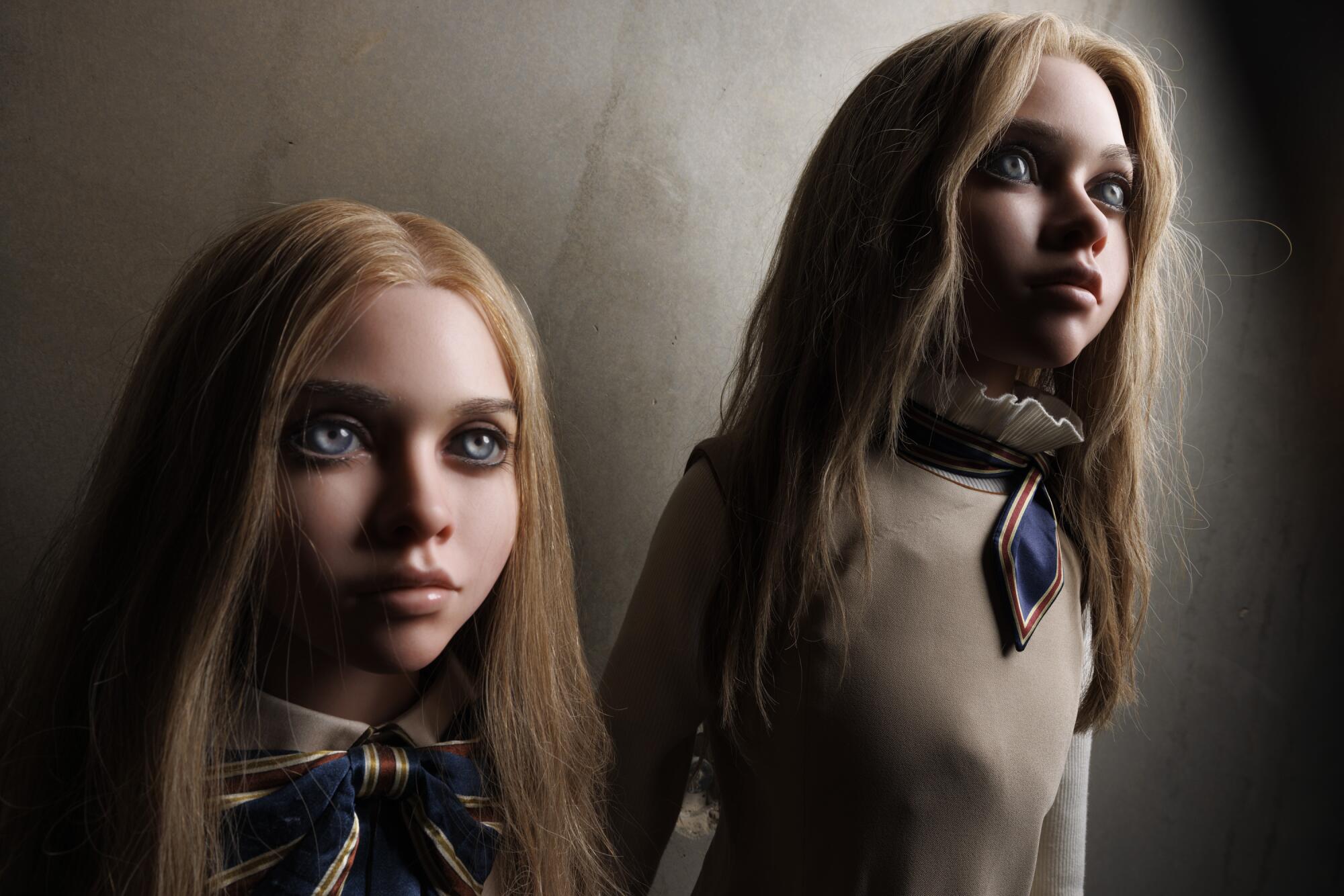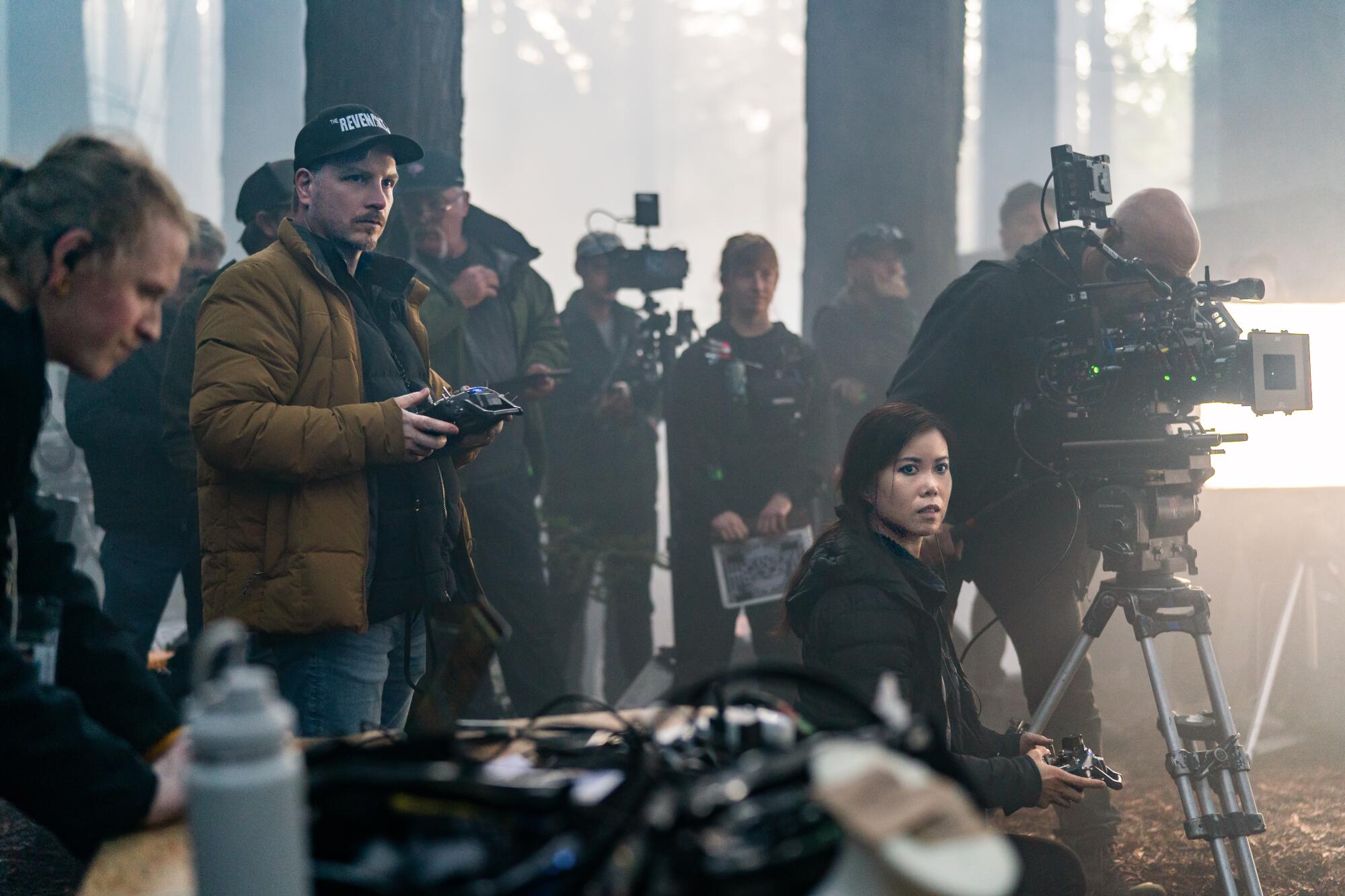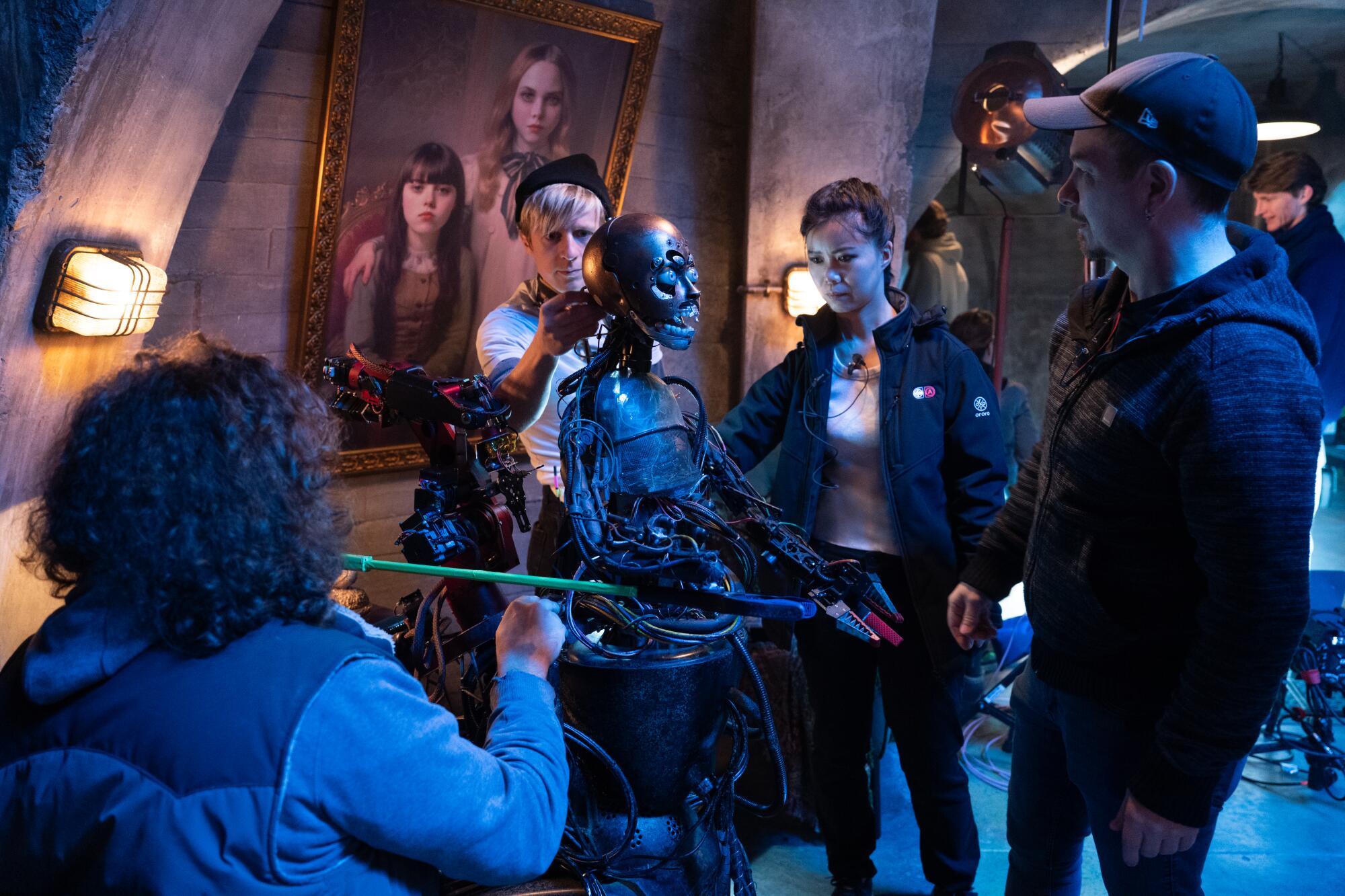‘Long Story Short’ is a family’s time-skip-filled trip down memory lane
The glass partition wall in Lisa Hanawalt’s office is lined with reference sheets dedicated to the members of the central family in “Long Story Short.”
Each page lists a character’s name, birth month and year — along with their zodiac sign — and a dated timeline of full body images that tracks how they look at different ages. Depending on the character, this includes their designs as children, teens and middle-aged adults.
During a mid-August morning at ShadowMachine studio, Hanawalt sits at her desk, pulling up different looks of earlier incarnations of the characters that she did before their final designs were set along with newer works in progress. Raphael Bob-Waksberg sits just behind her as they point out little details that they’re fond of and bounce their thoughts back and forth on whether certain characters might drastically change their appearance one year, as people tend to do.
“It’s a fun thing you don’t get to do on a lot of animated shows,” says Bob-Waksberg, the creator and showrunner of “Long Story Short.” “To evolve with our characters and dress them up and have so many different looks for them.”
On most animated sitcoms, characters are trapped in time: perpetually the same age, usually wearing the same clothes, rarely even getting a haircut — no matter how many holiday episodes they get through the years. Not so on “Long Story Short,” where the passage of time is a feature.
“It’s really fun to get to know the characters and to think about their aesthetic,” says Hanawalt, the show’s supervising producer. “We have to draw a lot of different versions of everybody.”
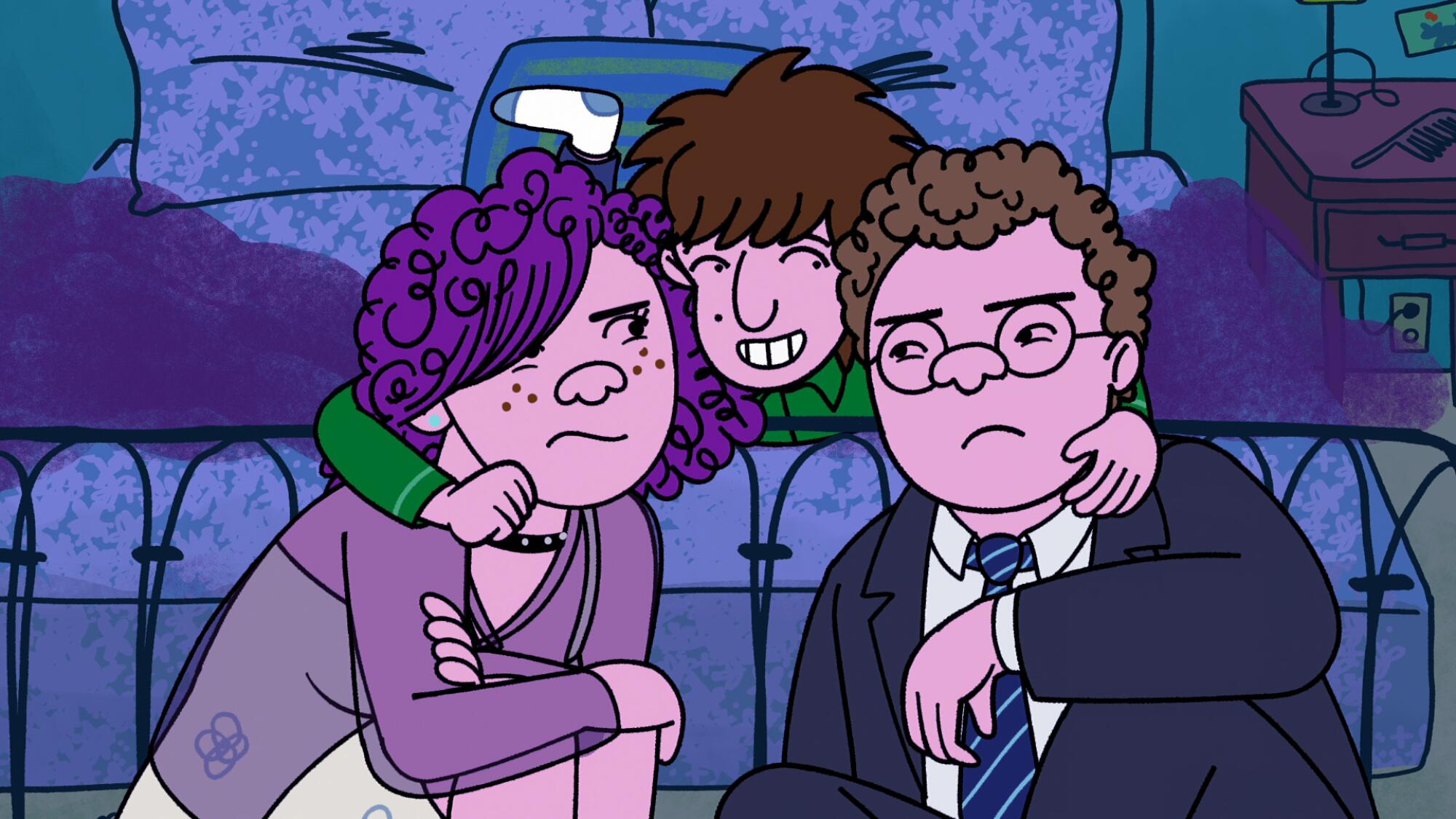
Siblings Shira, left, Yoshi and Avi Schwooper in “Long Story Short.”
(Netflix)
Launching Friday on Netflix, “Long Story Short” follows the Schwoopers, a Bay Area family whose portmanteau last name is a blend of the parents’ Schwartz and Cooper, through the ups and downs of their lives. The show’s cast includes Lisa Edelstein and Paul Reiser, who voice the parents Naomi and Elliot, respectively, and Ben Feldman, Abbi Jacobson and Max Greenfield as the Schwooper children, Avi, Shira and Yoshi.
Their story unfolds over time across both everyday happenings and milestones, with each self-contained episode jumping between moments that reverberate from anywhere in the 1950s to 2020s.
“It feels cumulative, even though the episodes themselves are not necessarily connected directly,” Bob-Waksberg says. “We thought a lot about emotional arcs more than narrative arcs. Can we feel like these characters have gone on a journey, even though we’re seeing the [story] out of order?”
“Long Story Short” is Bob-Waksberg’s first new show since the conclusion of “Bojack Horseman,” the acclaimed adult animated series that ended in 2020, about a washed up former sitcom star and his struggles set in an alternate Hollywood where humans lived alongside anthropomorphic animals. While “Bojack” didn’t shy away from showing how terrible parents were the root cause of various characters’ troubles, “Long Story Short” is a more nuanced take on dysfunction where it’s not as easy to place blame.
“As you get older, you kind of realize, we’re all screwed up in different ways and most of us didn’t have parents that bad,” Bob-Waksberg says. “We had parents who were trying and in some ways succeeding, and in other ways, not quite giving us what we needed.”
The show marks the pair’s third animated series together. Hanawalt served as the production designer and producer on “Bojack” before developing her own series, “Tuca & Bertie,” on which Bob-Waksberg served as an executive producer. But their easy rapport as they comment on a short clip of sauce exploding and whether a character is the type of person to only own one suit — as well as when the conversation detours into listing actors they insist the other likes after a missed film reference — makes it obvious that their friendship runs much deeper.

Longtime friends Raphael Bob-Waksberg and Lisa Hanawalt have previously worked together on “Bojack Horseman” and “Tuca & Bertie.”
(Jason Armond / Los Angeles Times)
Bob-Waksberg and Hanawalt explain that even during their high school years in Palo Alto, where they crossed paths as theater kids and became friends, they would talk about working on projects together and dream up TV show ideas. Describing Hanawalt as one of his favorite people and artists, Bob-Waksberg says she is the first person he thinks of whenever he needs someone for artistic work.
After hearing Bob-Waksberg’s idea for “Long Story Short,” “I just immediately felt like I knew what it should look like,” says Hanawalt. “That it should look like Sunday funnies, comics and ‘Peanuts.’ … I thought this should be more hand-drawn and loose. The warmth of the show, but also playing against how serious some of the subject matter is, I thought [that style] would help warm it up a bit.”
Though Hanawalt says backgrounds are not her forte, she had a vision of what she saw for the world and started drawing houses and buildings that resembled those they grew up in. Bob-Waksberg credits that as the reason for the show being set in Northern California.
Another reason Hanawalt wanted to work on the show was because it involved designing humans — something she’s leaned away from in the past.
“All the other stuff I get sent is for animals [and] animal people,” she says. “People see me as the animal lady, which I am — I do love anthropomorphic animals and plants. But I was actually leaning toward something more realistic. … I don’t want to get pigeonholed. And doing the same thing over and over, it gets really boring to me. So this was a fun challenge, drawing humans that are as cute as animals.”
Hearing this, Bob-Waksberg is amused by how aspects from their past have come to define them.
“I was just thinking about how 13, 14 years ago, I was developing a whole bunch of TV shows,” he says. “The one that went was the animated one and now I’m a cartoon guy, which I don’t resent. It’s been very good for me. But it’s so funny, [to think that] there’s another universe in which this other show went and then I’d be known as that kind of writer.”
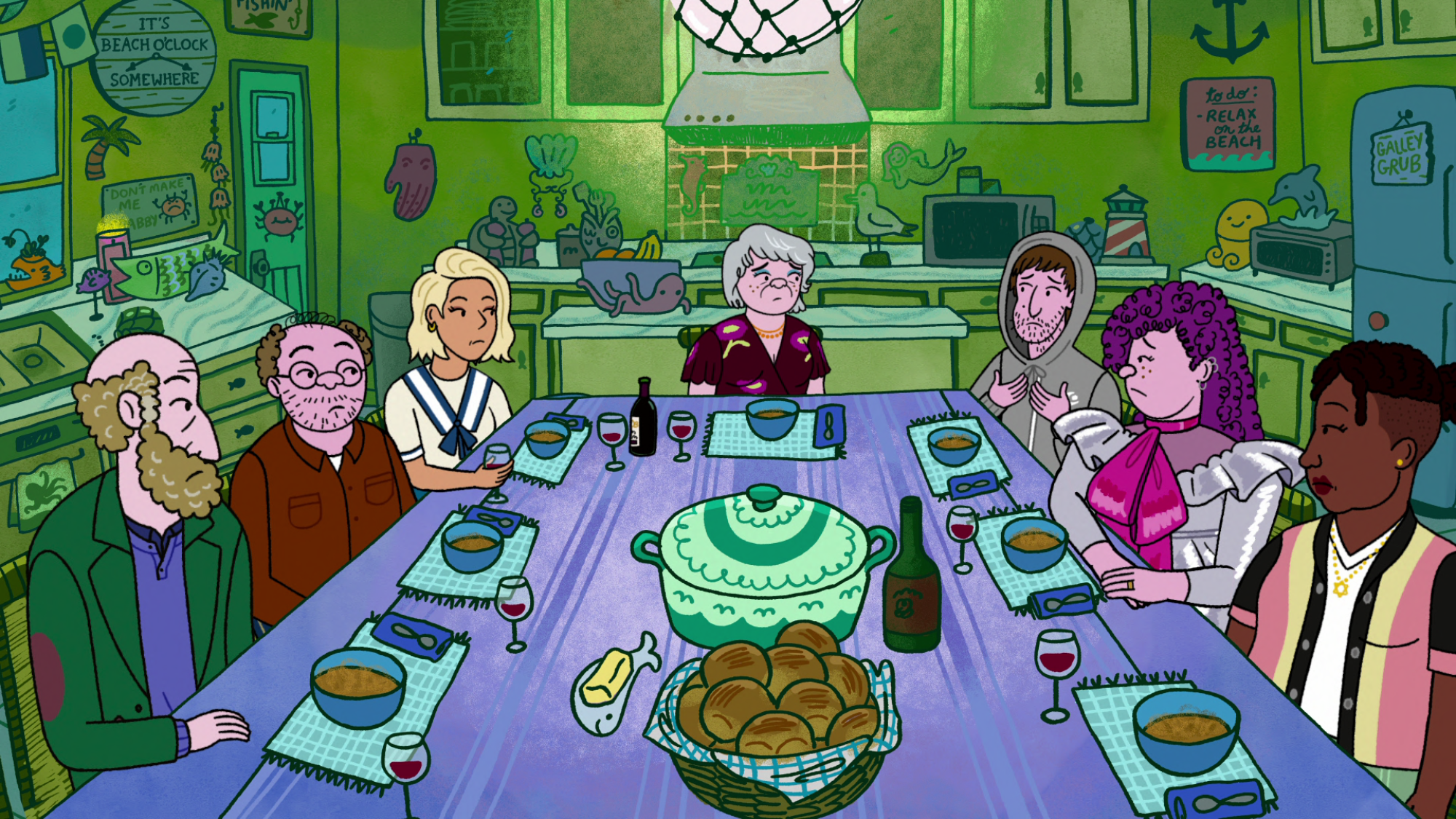
The Schwooper family in an episode of “Long Story Short.”
(Netflix)
Both Bob-Waksberg and Hanawalt acknowledge it’s still a tough time for the industry, including for writers looking for work and creatives trying to get things made. Both mention having pitched different ideas that they were certain would be their next projects that ultimately went nowhere.
“I’m glad to work on this because I’m happy to not be a showrunner right now,” Hanawalt admits. “‘Tuca & Bertie’ wiped me out [and] I didn’t have enough juice to keep pitching.”
Still, Bob-Waksberg believes animation is one of the few places were shows based on original ideas have a chance, and for that he and Hanawalt are both grateful because they’d rather work on their own ideas than play in someone else’s sandbox. In other spaces, studios appear to only show interest on ideas based on existing IP like a book, news article or podcast. They also remain hopeful that, in time, things will get better.
“The appetite for original, good shows and animated shows is always there,” Hanawalt says. “That’s consistent. The audience is there. It’s just a matter of getting it to them.”
Although the show centers a Jewish family in Northern California and includes nods to his upbringing, Bob-Waksberg has been clear that “Long Story Short” is not autobiographical. But it is deeply personal. He explains that discussing the novel “Interior Chinatown,” which confronts the interplay of representation and identity, with author Charles Yu was one of the things that made him think about what it would be like to address his own identity in his work.
“It felt like it opened up this new door of story possibility that I hadn’t considered before,” Bob-Waksberg says. “One of the interesting things about working on this show is unpacking [how], especially in conversation with my other writers and the actors and other people, some things that I attributed to being Jewish is just my family.”
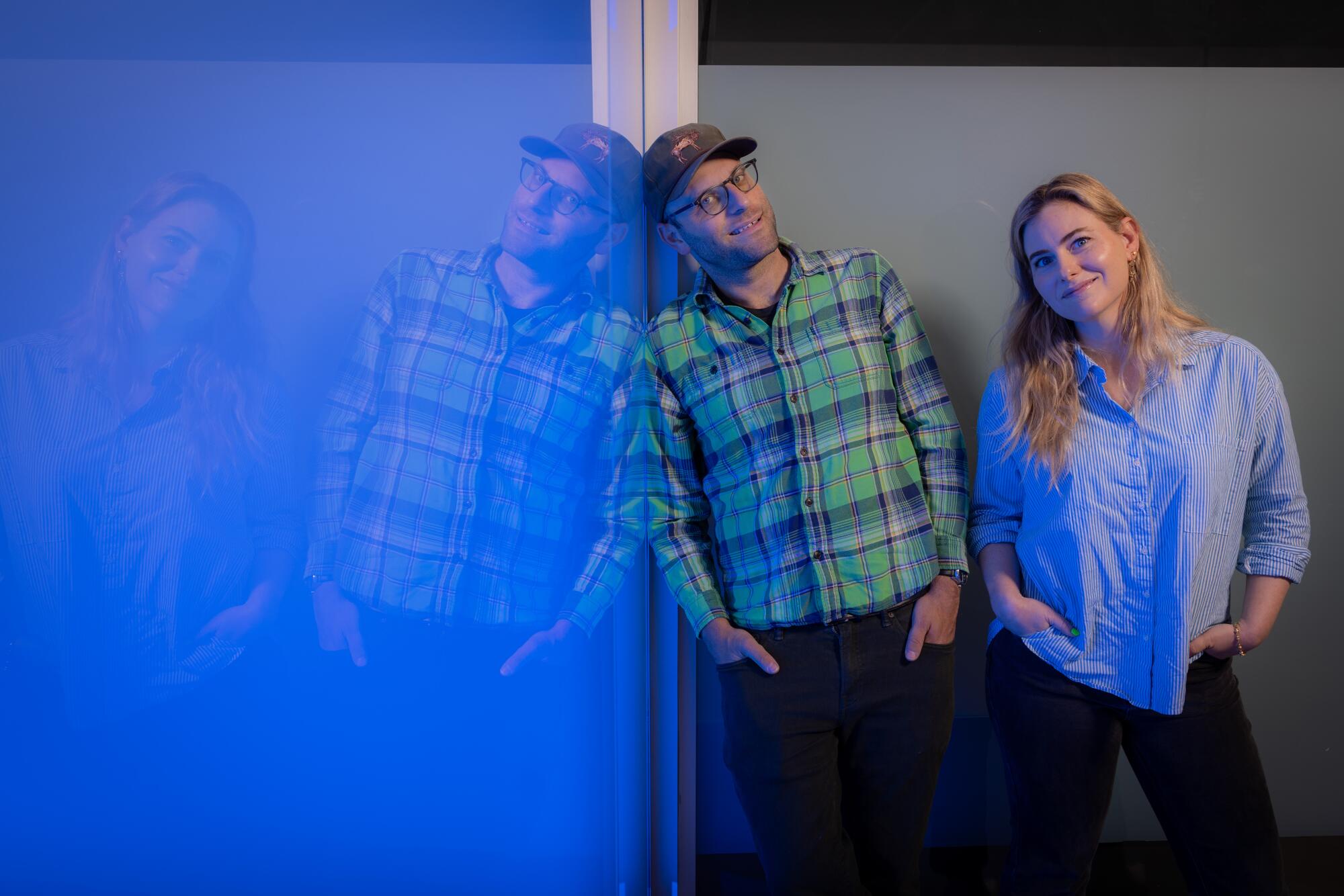
“Long Story Short” showrunner Raphael Bob-Waksberg and supervising producer Lisa Hanawalt.
(Jason Armond / Los Angeles Times)
While the series addresses the “trauma” — in quotes depending on which character you ask — rooted in people’s upbringing, it’s also filled with plenty of humor and heart. Most episodes are zoomed in on whatever more personal issue the Schwoopers are facing, and the passage of time is conveyed through characters’ ages and appearances rather than by referencing specific happenings and headlines that might be associated with that story’s era.
But one global event the series does acknowledge is the COVID-19 pandemic. For Bob-Waksberg, it was important to do so because it’s a collective trauma that affected everyone and should be remembered as such.
“This was a real dividing point for our world and for us all as individuals,” Bob-Waksberg says. “I feel like it’s been underrepresented in pop culture in a weird way [and] we all were very quick to move on.”
“Let’s not pretend that it never happened,” he continued. “I do feel like, as a storyteller, it is in some ways my job to be a document of the world.”
Recalling how important it was for him to hear stories from Holocaust survivors about their experiences when he was younger, Bob-Waksberg adds: “I don’t want to forget about these things.”
